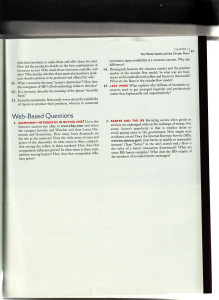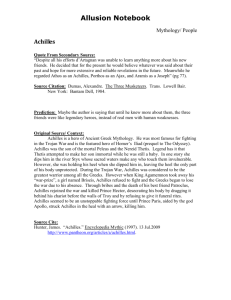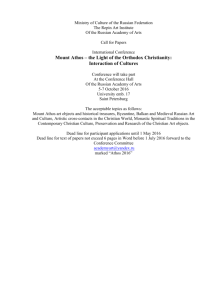Study Guide Three Musketeers
advertisement
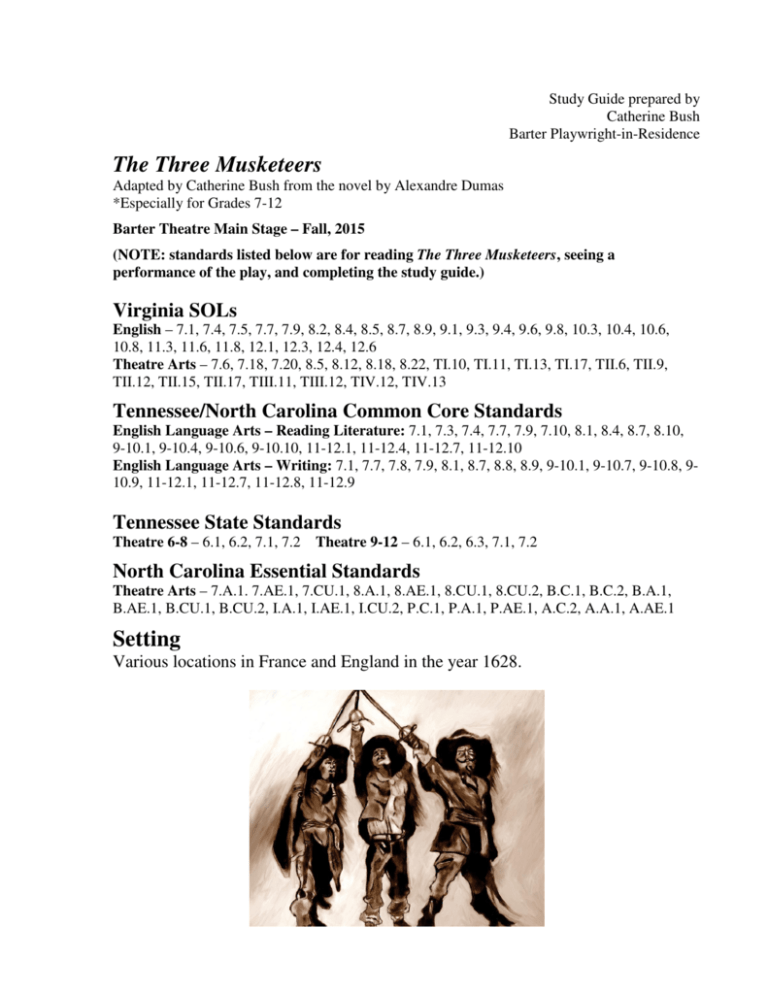
Study Guide prepared by Catherine Bush Barter Playwright-in-Residence The Three Musketeers Adapted by Catherine Bush from the novel by Alexandre Dumas *Especially for Grades 7-12 Barter Theatre Main Stage – Fall, 2015 (NOTE: standards listed below are for reading The Three Musketeers, seeing a performance of the play, and completing the study guide.) Virginia SOLs English – 7.1, 7.4, 7.5, 7.7, 7.9, 8.2, 8.4, 8.5, 8.7, 8.9, 9.1, 9.3, 9.4, 9.6, 9.8, 10.3, 10.4, 10.6, 10.8, 11.3, 11.6, 11.8, 12.1, 12.3, 12.4, 12.6 Theatre Arts – 7.6, 7.18, 7.20, 8.5, 8.12, 8.18, 8.22, TI.10, TI.11, TI.13, TI.17, TII.6, TII.9, TII.12, TII.15, TII.17, TIII.11, TIII.12, TIV.12, TIV.13 Tennessee/North Carolina Common Core Standards English Language Arts – Reading Literature: 7.1, 7.3, 7.4, 7.7, 7.9, 7.10, 8.1, 8.4, 8.7, 8.10, 9-10.1, 9-10.4, 9-10.6, 9-10.10, 11-12.1, 11-12.4, 11-12.7, 11-12.10 English Language Arts – Writing: 7.1, 7.7, 7.8, 7.9, 8.1, 8.7, 8.8, 8.9, 9-10.1, 9-10.7, 9-10.8, 910.9, 11-12.1, 11-12.7, 11-12.8, 11-12.9 Tennessee State Standards Theatre 6-8 – 6.1, 6.2, 7.1, 7.2 Theatre 9-12 – 6.1, 6.2, 6.3, 7.1, 7.2 North Carolina Essential Standards Theatre Arts – 7.A.1. 7.AE.1, 7.CU.1, 8.A.1, 8.AE.1, 8.CU.1, 8.CU.2, B.C.1, B.C.2, B.A.1, B.AE.1, B.CU.1, B.CU.2, I.A.1, I.AE.1, I.CU.2, P.C.1, P.A.1, P.AE.1, A.C.2, A.A.1, A.AE.1 Setting Various locations in France and England in the year 1628. Characters D’Artagnan – a young man yearning to be a musketeer The Three Musketeers Athos –cynical Porthos – a vain dandy Aramis –priest-like Monsieur de Tréville – Captain of the King’s Musketeers Planchet – Tréville’s servant Cardinal Richelieu - second most powerful man in France Rochefort – Richelieu’s spy Milady (Lady de Winter) – Richelieu’s spy Kitty – Milady’s servant Louis – King of France Anne of Austria – Louis’ wife, the Queen Constance Bonacieux – the Queen’s maid Monsieur Bonacieux – her father Lord Buckingham – the English Prime Minister Braddock – Buckingham’s butler Mystery Woman – Athos’s wife Abbess – the head of the Carmelite Convent Criminal – a convicted thief Felton – Buckingham’s assassin The Mob Tavern Patrons Richelieu’s Guards Patrons of the Golden Lily Inn Guests at the Palace Ball Richelieu’s Spies Soldiers Vocabulary Words contrary boorish fleur-de-lis henchman coy wanton province subjective delectable discretion rendezvous desist parry supersede commission prestige fraught sanctity sacrilege incessant bludgeon disconsolate vogue gist exemplary retribution fanatic presume lackey talisman Synopsis D’Artagnan, a poor but noble young man from Gascony, leaves his home to make his fortune in Paris. In his pocket he carries a letter of introduction to his father’s friend, Monsieur de Treville, captain of the King’s Musketeers. Upon his arrival, D’Artagnan encounters a man wearing an eyepatch who insults him. D’Artagnan challenges this oneeyed man to a duel and is rendered unconscious. When he wakes, he finds that his letter of introduction has been stolen. Undeterred, D’Artagnan makes his way to the musketeers’ headquarters, where he finds Monsieur de Treville chastising Athos, Porthos, and Aramis for dueling in public the night before. After the Three Musketeers leave, D’Artagnan introduces himself to de Treville, who informs D’Artagnan that the one-eyed man who stole his letter of introduction was Rochefort, one of Cardinal Richelieu’s spies. De Treville also tells D’Artagnan that all he can offer him is a place in the King’s guards, where he will be given the opportunity to earn his position as a musketeer. Thrilled with this chance, D’Artagnan runs excitedly from the room and into the street, where the Three Musketeers are walking. D’Artagnan collides with Athos, reinjuring Athos’s wounded shoulder. Athos is furious and challenges D’Artagnan, but D’Artagnan refuses to fight Athos until his shoulder is healed. D’Artagnan then offers Athos a potion that will heal his wound. Skeptical, Athos takes it and recovers instantly. Grateful, he introduces D’Artagnan to Aramis and Porthos. D’Artagnan and Athos are about to duel when the Cardinal’s guards happen upon them and threaten them with arrest. D’Artagnan joins forces with the Three Musketeers to defeat the Cardinal’s men. The Three Musketeers immediately take D’Artagnan into their inner circle. Synopsis (cont.) Upon Monsieur de Tréville’s recommendation, D’Artagnan seeks lodging in the home of Monsieur Bonacieux. As he and Bonacieux are negotiating the lease, they are interrupted by Monsieur Bonacieux’s daughter, Constance, who is employed as the Queen’s linen maid. Constance is carrying a note from the Queen that she needs delivered to No. 75 Rue de la Harpe. Because she is being followed by the Cardinal’s spies, she asks her father to deliver it, but he refuses. D’Artagnan volunteers for the mission. We discover that the note is being delivered to Lord Buckingham, England’s Prime Minister, who has secretly journeyed to Paris in order to rendezvous with Queen Anne, with whom he has fallen in love. However, when Queen Anne meets with Buckingham, she rebuffs all his advances. Though she loves him, she will never break her vows. Heartbroken, Buckingham agrees to return to England. Before he leaves, Anne gives him a parting gift: a diamond set that was given to her by her husband. Hoping to discredit the Queen, Richelieu is dismayed to discover that Buckingham has slipped through his fingers unharmed. But when he learns about the Queen’s parting gift, Richelieu devises a plan; he will convince the King to throw a ball and insist that the Queen where the diamond set. When she is unable to do so, the King will be forced to acknowledge his wife’s unfaithfulness. To ensure his plan will work, Richelieu employs the services of Lady de Winter, his spy in London, who manages to steal two of the diamonds in the set while visiting Buckingham. When Queen Anne learns about the upcoming ball, she writes a letter to Buckingham in London requesting the return of the diamonds. Constance gives the letter to D’Artagnan who, with the Three Musketeers in tow, starts off at once for England. While waiting for a ship on the French coast, the four friends are ambushed at an inn. Athos, Porthos and Aramis hold off Richelieu’s men, D’Artagnan slips away and makes the crossing. In London, he delivers the note to Buckingham, who then discovers that two of the diamonds are missing. He quickly orders duplicates made and sends the restored set back to Paris with D’Artagnan. When Richelieu sees the Queen arrive at the ball wearing the full set, he is humiliated. He starts to leave the ball when he spies D’Artagnan and Constance in conversation. Eavesdropping, he learns of a rendezvous they have planned for the next night. Knowing that Constance was involved in the diamonds’ return, Richelieu plots his revenge. Synopsis (cont.) The next night, while waiting to meet Constance, a drunken Athos tells D’Artagnan of the woman to whom he was once married. Out riding one day, his young bride had an accident and was rendered unconscious. While tending to her, Athos discovered that she had been branded with the fleur-de-lis – the sign of a convicted murderer. Heartbroken and betrayed, Athos carried out her execution and hanged her. At the end of the story, Athos passes out from drink, and while Aramis and Porthos put him to bed, D’Artagnan leaves to meet Constance. He arrives at their rendezvous only to discover that Constance has been kidnapped by Rochefort and taken to the Bastille. D’Artagnan pledges to rescue her. The next day, D’Artagnan learns from Monsieur de Treville that Constance has been removed from the Bastille and taken to a new location. Determined to find clues to her whereabouts, D’Artagnan enlists the service of Monsieur de Treville’s servant, Planchet. Planchets lover Kitty is Lady de Winter’s maid; now that Milady has returned to Paris, D’Artagnan is certain she is involved in Constance’s disappearance. Donning a disguise – and with Kitty’s help – D’Artagnan slips into Milady’s room and begins searching for clues. When Milady discovers him, she thinks at first he is Rochefort, with whom she has been having an affair. She gifts D’Artagnan with a pendent and kisses him. When she realizes that he is not Rochefort, she attacks him with a knife. They fight, and he tears her dress, revealing a branded fleur-de-lis on her shoulder. Furious at having her secret made known, Milady attacks with renewed fury and D’Artagnan barely escapes with his life. Milady goes to see Richelieu and demands that he give her a carte blanche to kill D’Artagnan. Richelieu agrees, but first Milady must return to England and arrange the assasination of Lord Buckingham. Milady does so, then returns to the Carmelite convent in Bethune to await further instructions. Meanwhile, D’Artagnan, having recovered from his wounds, meets up with the Three Musketeers and tells them what has occurred. Athos recognizes the pendent as a family heirloom he had given his wife long ago. That, along with D’Artagnan’s description of Milady, convinces him that his wife somehow survived the hanging and is now their enemy. Just then Planchet arrives with the news that Constance has been resued from prison by the Queen and is hiding in a convent near Bethune, disguised as a nun. D’Artagnan and the Three Musketeers rush off to rescue her. Synopsis (cont.) But they are too late. Milady has discovered Constance’s true identity and forces Constance to drink poison. Milady escapes just as D’Artagnan and his friends arrive. As Constance dies in D’Artagnan’s arms, Athos vows to find Milady and exact revenge. He tracks her to an inn on the French coast and kills her. Before he leaves, Athos takes the carte blanche Richelieu gave to Milady an in turn gives it to D’Artagnan. Heartbroken, D’Artagnan returns home to break the news of Constance’s death to Monsieur Bonacieux. Upon his arrival, he discovers Bonacieux has been killed and Rochefort waiting for him. The two men duel and D’Artagnan slays his enemy. Cardinal Richelieu appears and orders D’Artagnan’s arrest, but has to renig when D’Artagnan shows him the carte blanche, granting the bearer permission to do what he has done and signed by Richelieu himself. Foiled, Richelieu allows D’Artagnan to go free. D’Artagnan returns to the musketeers headquarters where Monsieur de Treville makes him a full musketeer. At the plays’s end, D’Artagnan and his three friends start off a new adventure – all for one, and one for all! Biography of the Author – Alexandre Dumas Alexandre Dumas was born Dumas Davy de la Pailleterie on July 24, 1802, in Villers-Cotterêts, France. The Dumas family name was adopted from Alexandre’s grandmother, an enslaved Haitian woman. Alexandre’s father took the name Dumas when he enlisted in Napoleon’s army, where he rose to the rank of general at the age of 31, the highest rank of any black man in a European army. After his father’s death in 1806, Alexandre attended school for a while before dropping out to take a job assisting a local notary. In 1822, Dumas moved to Paris. He began writing plays, both comedies and dramas. He was also a prolific writer of essays, short stories and novels, achieving widespread success with The Count of Monte Cristo and The Three Musketeers, initially published as serials. These novels made Dumas a household name in France and a popular author throughout much of Europe. With the money he earned, Dumas built the Château de Monte Cristo and spent much of his time writing and entertaining there before debt overtook him, forcing him to sell the property. He fled to Belgium in 1851, and later to Russia, to evade creditors. Dumas had a son, also named Alexandre, who followed in his literary footsteps. Dumas died on December 5, 1870. He was buried in the cemetery of Villers-Cotterêts. In 2002, his body was moved to the Panthéon in Paris, where Dumas rests among such other French literary greats as Émile Zola, Victor Hugo and Jean-Jacques Rousseau. Biography of the Playwright– Catherine Bush Catherine Bush has been Barter Theatre’s playwright-inresidence since 2007. Her produced plays include: The Other Side of the Mountain, The Quiltmaker, Comin’ Up A Storm, Wooden Snowflakes, Tradin’ Paint, Where Trouble Sleeps, Walking Across Egypt, I’ll Never Be Hungry Again (book & lyrics), The Frankenstein Summer, unhINGEd, The Executioner’s Sons, The Controversial Rescue of Fatty the Pig, and Just a Kiss, which was a finalist for the 2007 Steinberg Award presented by the American Theatre Critics Association. Plays for Young Audiences: Cry Wolf!, Sleeping Beauty, Rapunzel, The Scarlet Letter, The Adventures of Tom Sawyer, The Legend of Sleepy Hollow, All I Want for Christmas is My Two Front Teeth, My Imaginary Pirate, The Call of the Wild, The Princess and the Pea, Aesop’s Fables, The Red Badge of Courage. Frosty, Rudolph, Santa Claus is Coming to Town, Mother Goose: The Musical, ‘Twas the Night Before Christmas, Jingle All the Way, and Old Turtle and the Broken Truth. A Brief History Barter Theatre was founded during the Great Depression by Robert Porterfield, an enterprising young actor. He and his fellow actors found themselves out of work and hungry in New York City. Porterfield contrasted that to the abundance of food, but lack of live theatre, around his home region in Southwest Virginia. He returned to Washington County with an extraordinary proposition: bartering produce from the farms and gardens of the area to gain admission to see a play. Barter Theatre opened its doors on June 10, 1933 proclaiming, “With vegetables you cannot sell, you can buy a good laugh.” The price of admission was 40 cents or the equivalent in produce, the concept of trading “ham for Hamlet” caught on quickly. At the end of the first season, the Barter Company cleared $4.35 in cash, two barrels of jelly and enjoyed a collective weight gain of over 300 pounds. Playwrights including Noel Coward, Tennessee Williams and Thornton Wilder accepted Virginia ham as payment for royalties. An exception was George Bernard Shaw, a vegetarian, who bartered the rights to his plays for spinach. Today, Barter Theatre has a reputation as a theatre where many actors performed before going on to achieve fame and fortune. The most recognized of these alumni include Gregory Peck, Patricia Neal, Ernest Borgnine, Hume Cronyn, Ned Beatty, Gary Collins, Larry Linville and Frances Fisher. The list also included James Burrows, creator of Cheers, Barry Corbin, and the late Jim Varney Robert Porterfield passed away in 1971. His successor, Rex Partington, had been at Barter in the 1950s as an actor and in the 1970s as stage manager. Rex returned as chief administrator from 1972 until his retirement in 1992. In March 2006, he passed away. Richard Rose was named the producing artistic director in October 1992. In that time, attendance has grown from 42,000 annual patrons to more than 163,000 annual patrons. Significant capital improvements have also been made. Including maintenance to both theatres, and in 2006, the addition of The Barter Café at Stage II and dramatic improvements to Porterfield Square. Barter represents three distinct venues of live theatre: Barter Theatre Main Stage, Barter Theatre Stage II and The Barter Players. Barter Theatre, with over 500 seats, features traditional theatre in a luxurious setting. Barter Stage II, across the street from Barter Main Stage and beyond Porterfield Square, offers seating for 167 around a thrust stage in an intimate setting and is perfect for more adventurous productions. The Barter Players is a talented ensemble of actors, producing plays for young audiences throughout the year. History is always in the making at Barter Theatre, building on legends of the past; Barter looks forward to the challenge of growth in the future. From the Page to the Stage! How does a book become a stage play? Here are some of the elements that went into Barter Theatre’s production of The Three Musketeers… 2. Director/Actors 1. Script It all starts here. A playwright (in this case, Catherine Bush) turns the prose of literature into dialogue and dramatic action. This is called “adapting”. Sound easy? Try it yourself! Pick a scene from your favorite story and adapt it into a scene for the stage. Try not to use the narrative voice – focus instead on creating “dialogue” between the characters. 4. Costumes/Wigs The costume designer is responsible for creating a different look for each character while maintaining the overall aesthetic of the production. Each actor’s costume must be tailored to fit and be built to take the wear-and-tear of 8 shows a week! Also, in a show where the actor is required to play more than one character, the design must incorporate a method to facilitate “quick changes”. The wig designer is responsible for designing, building and styling the wigs that will appear in the show. Like the costumes, wigs are necessary to help distinguish characters. Try it yourself! Design a costume/wig for the character in your scene. Make sure your costume includes a mechanism to make “quick changes possible. The director and actors begin the rehearsal process. The director “blocks” the play, which means he tells the actors where to move and stand and sit. The actors work on learning their lines, finding their character’s motivation and creating the world of the play. The length of a rehearsal process for a Barter Theatre production ranges from 100 – 120 hours spread out over 4-6 weeks, depending on the play. 3. Set Design The set designer designs a set that will not only serve the aesthetic needs of the production by creating beautiful visuals that represent the various locations in the story (i.e. the streets of Paris, the ballroom in the Louvre Palace, D’Artagnan’s room) but also function as a safe environment upon which the actors will move (or be moved). A good set design will also allow the action to flow from one scene to another smoothly, 5. Props with seamless transitions. A breakaway chair! The Cardinal’s ring! Try it yourself! Milady’s vial of poison! These are a few Using the scene you adapted, examples of the props designed and built by design a set that will both Barter’s props department for this visually serve the story and production. A prop is defined as an object function effectively for the used on stage by actors for use in the plot or actors. story line of a theatrical production. Try it yourself! Design and build the props you will need for your scene. 6. Lights/Sound Lights not only illuminate the actors and pull focus to various spots on the stage but, together with sound, help create a mood. Lights and sound can also, along with the set, help establish location. The sound of horses hooves, the glow of moonlight, and voila! We are on a dark road in France in the year 1628! Try it yourself! Put together a soundtrack for your scene that establishes place and mood. Feel free to use recorded music/sound effects or perform it live! 7. Stage Manager/Crew The Stage Manager attends all the rehearsals and once the show goes into production, is “in charge”, calling all the sound and light cues and maintaining the integrity of the piece during its run. The SM is aided in these endeavors by the Crew, the unsung heroes who work backstage moving sets, changing wardrobe, placing props – whatever is necessary for the show to go on! Word Search Find the following words in the puzzle below: D’Artagnan, Athos, Richelieu, en garde, Aramis, Porthos, sword, fleur-de-lis, Paris, duel, Three Musketeers, Planchet, diamond set, Lady de Winter, Rochefort, Lord Buckingham, King Louis, Bastille, Constance, Queen Anne, Alexandre Dumas, Barter Theatre, Felton R E T N I W E D Y D A L E X N D A R T A G N A N V E U M L D I L C O N S T A N C E F O U A A E N N A N E E U Q L R E R S M X E D R A G N E E D L A I U O A M A T H O S U B L M R E F N N E I P A I R U I I A I E E D D R O W S D C T S P L I P L S R E E T E K S U M E E R H T E E Y E L I A S O H T R O P O T D P I N B L X C Z A L W D N N U S G N T S I U O L G N I K I M H Q J H R P L A N C H E T B A R T E R T H E A T R E X K M S T R O F E H C O R U W X I True and False Write T if the statement is True and F if the statement is False. 1. ____ Monsieur de Treville is the captain of the King’s Musketeers. 2. ____ The headquarters of the King’s Musketeers was at No. 75 Rue de la Harpe. 3. ____ D’Artagnan came to Paris hoping to join the King’s Guards. 4. ____ The Three Musketeers are Athos, Porthos and Aramis. 5. ____ Milady (Lady de Winter) was once married to Athos. 6. ____ Monsieur Bonacieux is Rochefort’s landlord. 7. ____ Rochefort is a spy for Cardinal Richelieu. 8. ____ Porthos fall is in love with Constance Bonacieux. 9. ____ Aramis hopes to someday leave the musketeers and become a priest. 10. ____ The Three Musketeers was written by Alexandre Dumas. 11. ____ Kitty gets into a fight with D’Artagnan and stabs him. 12. ____ Constance Bonacieux is sent to England to assassinate Lord Buckingham. 13. ____ Lady de Winter is branded with the fleur-de-lis. 14. ____ Cardinal Richelieu gives Milady written permission to do as she wishes. 15. ____ At the end of the story, D’Artagnan is finally made a musketeer. Matching Match the person in the 1st column with the corresponding description in the 2nd. 1. D’Artagnan 2. Buckingham 3. Rochefort 4. Aramis 5. Milady 6. Porthos 7. Constance 8. Richelieu 9.. Athos a. branded with the fleur-de-lis b. the Queen’s linen maid c. the Cardinal of France d. Prime Minister of England e. married to Milady f. wants to be a priest g. a native of the province of Gascony h. a bit of a dandy i. Richelieu’s henchman Questions/Activities 1. Read The Three Musketeers by Alexandre Dumas then attend a performance of Barter’s production. How are they similar? How are they different? Write a paper that compares and contrasts the book with Barter’s production! 2. In this story, Milady has been branded with a fleur-de-lis, marking her as a criminal. Using the internet, research the historical significance of the fleur-de-lis. What did it symbolize originally? How has the meaning changed over the years? What does it symbolize now? Present your findings to the class. 3. D’Artagnan is a native of Gascony, a province in France. Using the internet, research the history and culture of Gascony. Where is it located? What language (dialect) is spoken there? What is the basis for its economy? What sort of architecture exists? How has Gascony changed from the 1620’s when D’Artagnan lived there? Present your findings to the class. “All for one and one for all!” 4. Although The Three Musketeers is a work of fiction, five of the major characters actually existed and played a major role in French history: King Louis XIII, Anne of Austria (his Queen), Cardinal Richelieu, Lord Buckingham, and Monsieur de Treville. King Louis XIII Anne of Austria The Duke of Buckingham Cardinal Richelieu Monsieur de Treville Pick one of these characters and research their lives. How do they compare to their characters as portrayed by Alexandre Dumas? How do their relationships to each other compare? How does knowledge of the history surrounding this time period make the play more accessible? Discuss how the various subjects studied in school often overlap. 5. Using pictures from magazines or newspapers, construct a collage representing one of the characters from The Three Musketeers. Display the collages around the room and see if the other students are able to match the collage to the character. Write it! Select your favorite character from the play, pick an important day in their life that influences this play then write a journal entry about that day as that character. For example, you might pick the character of Milady and write about the day you stole the diamonds from Buckingham, or you might pick the character of Constance and write about the day you met D’Artagnan. Be as specific as possible and write as that character would. Write a critique of Barter Theatre’s production of The Three Musketeers. Be sure to include what you liked, didn’t like and what you would have done differently. 6. Where is the city of Calais located in France? How far away is it from Paris? Using the Internet, plot a course from Calais to Paris and research the various modes of transportation one would use to get there (assume you don’t have a car). How does this compare to the transportation options available to the Three Musketeers in 1628? Discuss. Comedy vs. Tragedy comedy: a dramatic work that is light and often humorous or satirical in tone and that usually contains a happy resolution of the thematic conflict. tragedy: A drama or literary work in which the main character is brought to ruin or suffers extreme sorrow, especially as a consequence of a tragic flaw, moral weakness, or inability to cope with unfavorable circumstances. Given these definitions, would you categorize The Three Musketeers as a comedy or a tragedy? Cite three samples from the play to support your position. Does a character’s point-ofview influence your findings? Discuss. En Garde! The Three Musketeers is famous for the amount of swordplay used in telling the story. The actors in Barter’s Resident Company underwent 40 hours of fight training with Fight Director Rod Kinter in preparation for this show. In doing so, they were taught fight terminology that corresponded with some basic moves. Look up some of the following terms to see what they mean: advance attack en garde feint engagement guard parry lunge point in line recover riposte Next, look up the following types of weapons – how are they different? sword foil rapier epee dagger broadsword cutlass Extra Credit - PERSUADE ME! As Milady de Winter, write a paper persuading Athos to spare your life. Suggested Further Reading Other books by Alexandre Dumas: Twenty Years After The Man in the Iron Mask The Count of Monte Cristo Marguerite de Valois La Reine Margot Books written about Alexandre Dumas The Black Count: Glory, Revolution, Betrayal, and the Real Count of Monte Cristo by Tom Reiss Alexandre Dumas: The King of Romance by F. W. J. Hemmings Alexandre Dumas: Genius of Life by Claude Schopp and J. Koch
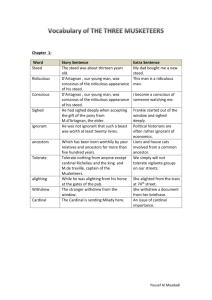
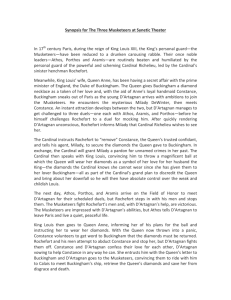
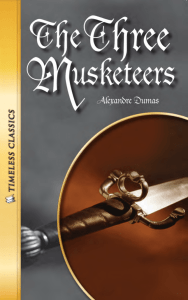
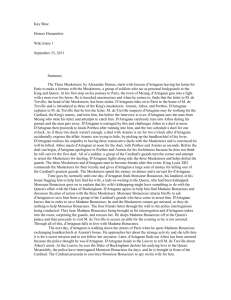
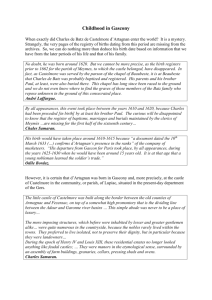
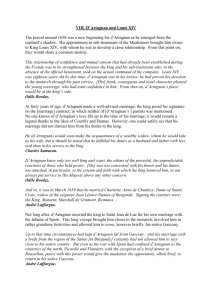
![File - FNBE 04/13 [Edwin ho khai vun]](http://s3.studylib.net/store/data/007076895_1-e5117b8a55a4f9086eca6abb55a2fe76-300x300.png)
